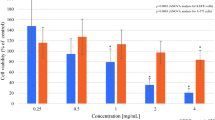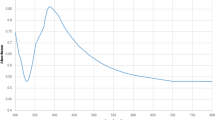Abstract
The skin mucus in lower vertebrates such as fish with strong innate immune system has many unique and valuable bioactive compounds that can be used for inducing apoptosis in cancer cells. This study was looking for the cytotoxic potential of mucus from the two fish species, including round goby (Neogobius melanostomus) and common carp (Cyprinus carpio), and inducing apoptosis in MCF7 and LNCaP cancer cell lines via influencing P53 gene expression and cell cycle arrest. Results showed that the both mucus types have cytotoxic effects on the both cancer cell lines whereas they have no severe effect on normal primary fibroblast cells. In addition, round goby mucus and common carp mucus selectively induced apoptosis in the LNCaP and MCF7 cells, respectively, through up-regulating P53 gene and arresting cell cycle at the G1 phase. Taken together, this study suggested that the both mucus types can selectively influence P53 pathway and induce apoptosis in especial cancer cells. The skin mucus derived from round Goby and common Carp can be a promising candidate for investigation about apoptosis and molecular targeting therapy in cancer.






Similar content being viewed by others
References
Arulvasu C, Selvamathi S, Babu G, Dhanasekaran G (2012) Effect of crude and partially purified epidermal mucus proteins of marine catfish Tachysurus dussumieri on human cancer cell line. JASR 1:164–169
Astuti P, Utami ED, Nugrahani AW, Sudjadi S (2012) Genistein abrogates G2 arrest induced by curcumin in p53 deficient T47D cells DARU. J Pharm Sci 20:82
Balasubramanian S, Revathi A, Gunasekaran G (2016) Studies on anticancer, haemolytic activity and chemical composition of crude epidermal mucus of fish Mugil cephalus. Int J Fish Aquat Stud 4:438–443
Bergsson G, Agerberth B, Jörnvall H, Gudmundsson GH (2005) Isolation and identification of antimicrobial components from the epidermal mucus of Atlantic cod (Gadus morhua). FEBS J 272:4960–4969
Chang F, Syrjänen S, Syrjänen K (1995) Implications of the p53 tumor-suppressor gene in clinical oncology. J Clin Oncol 13:1009–1022
Chen J (2016) The cell-cycle arrest and apoptotic functions of p53 in tumor initiation and progression. Cold Spring Harbor Persp Med 6:a026104
Crawford AD, Esguerra CV, de Witte PA (2008) Fishing for drugs from nature: zebrafish as a technology platform for natural product discovery. Planta Med 74:624–632
Denizot F, Lang R (1986) Rapid colorimetric assay for cell growth and survival: modifications to the tetrazolium dye procedure giving improved sensitivity and reliability. J Immunol Methods 89:271–277
Edmondson JM, Armstrong LS, Martinez AO (1988) A rapid and simple MTT-based spectrophotometric assay for determining drug sensitivity in monolayer cultures. J Tissue Cult Methods 11:15–17
Ferrari M, Fornasiero MC, Isetta AM (1990) MTT colorimetric assay for testing macrophage cytotoxic activity in vitro. J Immunol Methods 131:165–172
Fuochi V et al (2017) Antimicrobial and anti-proliferative effects of skin mucus derived from Dasyatis pastinaca (Linnaeus, 1758. Mar Drugs 15:342
Gobinath RAC, Ravichandran S (2011) Antimicrobial peptide from the epidermal mucus of some estuarine cat fishes. World App Sci J 12:256–260
Guzmán EA (2019) Regulated cell death signaling pathways and marine natural products that target them. Mar Drugs 17:76
Harper JW, Adami GR, Wei N, Keyomarsi K, Elledge SJ (1993) The p21 Cdk-interacting protein Cip1 is a potent inhibitor of G1 cyclin-dependent kinases. Cell 75:805–816
Harris F, Dennison SR, Singh J, Phoenix DA (2013) On the selectivity and efficacy of defense peptides with respect to cancer cells. Med Res Rev 33:190–234
Hellio C, Pons AM, Beaupoil C, Bourgougnon N, Le Gal Y (2002) Antibacterial, antifungal and cytotoxic activities of extracts from fish epidermis and epidermal mucus . Int J Antimicrob Agents 20:214–219
Khazir J, Riley DL, Pilcher LA, De-Maayer P, Mir BA (2014) Anticancer agents from diverse natural sources. Nat Prod Commun 9:1934578
Kumar P et al (2019) Comparative immunological and biochemical properties of the epidermal mucus from three brackishwater fishes. Proc Natl Acad Sci India Sect B 89:95–103
Kuppulakshmi C, Prakash M, Gunasekaran G, Manimegalai G, Sarojini S (2008) Antibacterial properties of fish mucus from. Eur Rev Med Pharmacol Sci 12:149–153
Kwak C-H et al (2015) Induction of apoptosis and antitumor activity of eel skin mucus, containing lactose-binding molecules, on human leukemic K562 cells. Mar Drugs 13:3936–3949
Lim KJ, Sung BH, Shin JR, Lee YW, Yang KS, Kim SC (2013) A cancer specific cell-penetrating peptide, BR2, for the efficient delivery of an scFv into cancer cells. PloS ONE 8:e66084
Livak KJ, Schmittgen TD (2001) Analysis of relative gene expression data using real-time quantitative PCR and the 2–∆∆CT method. Methods 25:402–408
Lowe SW, Ruley HE, Jacks T, Housman DE (1993) p53-dependent apoptosis modulates the cytotoxicity of anticancer agents. Cell 74:957–967
Marx J (1993) Cell death studies yield cancer clues. Science 259:760–762
Meek DW (2009) Tumour suppression by p53: a role for the DNA damage response? Nat Rev Cancer 9:714
Merritt AJ, Potten CS, Kemp CJ, Hickman JA, Balmain A, Lane DP, Hall PA (1994) The role of p53 in spontaneous and radiation-induced apoptosis in the gastrointestinal tract of normal and p53-deficient mice. Cancer Res 54:614–617
Polyak K, Waldman T, He T-C, Kinzler KW, Vogelstein B (1996) Genetic determinants of p53-induced apoptosis and growth arrest. Genes Dev 10:1945–1952
Subramanian S, MacKinnon SL, Ross NW (2007) A comparative study on innate immune parameters in the epidermal mucus of various fish species. Comp Biochem Physiol Part B 148:256–263
Teerasak E, Thongararm P, Roytrakul S, Meesuk L, Chumnanpuen P (2016) Prediction of anticancer peptides against MCF-7 breast cancer cells from the peptidomes of Achatina fulica mucus fractions. Comput Struct Biotechnol J 14:49–57
Tewari D, Rawat P, Singh PK (2019) Adverse drug reactions of anticancer drugs derived from natural sources. Food Chem Toxicol 123:522–535
van der Marel MC (2012) Carp mucus and its role in mucosal defense. Academic Press, Cambridge
Zhang C-X, Huang K-X (2005) Apoptosis induction on HL-60 cells of a novel polysaccharide from the mucus of the loach Misgurnus anguillicaudatus. J Ethnopharmacol 99:385–390
Acknowledgement
The authors thank 'Babol University of Medical Sciences'-Deputy of Research and Technology for providing laboratory instruments and financially supporting this research. This study was supported financially by Abadan Faculty of Medical Sciences with grant number 96U-279. This project approved by ethical Committe of Abadan Faculty of Medical Sciences (Ir.ABADANUMS.REC.1397.003).
Author information
Authors and Affiliations
Corresponding author
Additional information
Publisher's Note
Springer Nature remains neutral with regard to jurisdictional claims in published maps and institutional affiliations.
Rights and permissions
About this article
Cite this article
Alijani Ardeshir, R., Rastgar, S., Morakabati, P. et al. Selective induced apoptosis and cell cycle arrest in MCF7 and LNCap cell lines by skin mucus from round goby (Neogobius melanostomus) and common carp (Cyprinus carpio) through P53 expression. Cytotechnology 72, 367–376 (2020). https://doi.org/10.1007/s10616-020-00383-x
Received:
Accepted:
Published:
Issue Date:
DOI: https://doi.org/10.1007/s10616-020-00383-x




